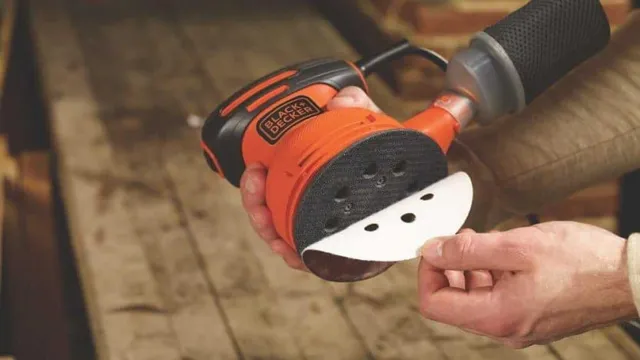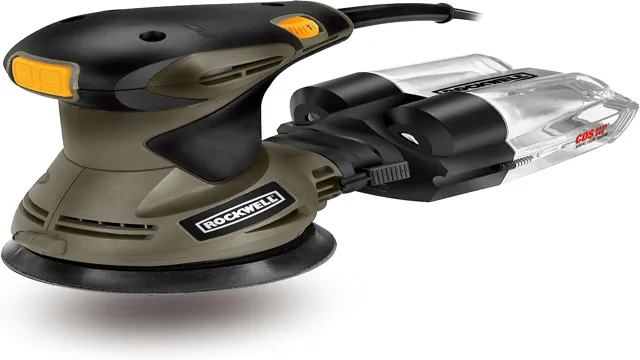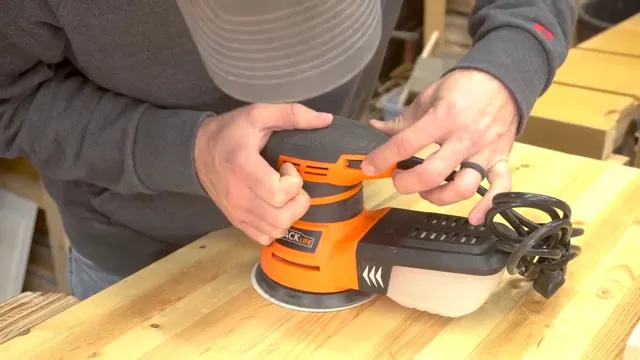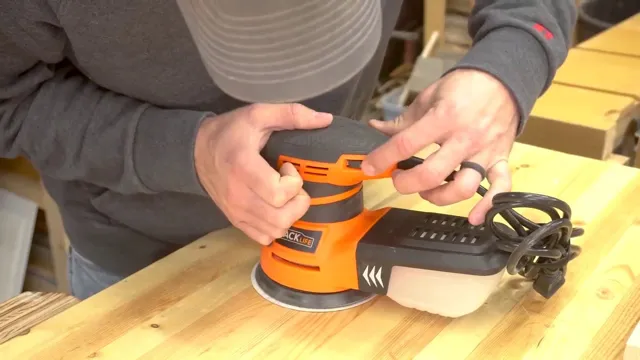Which is Better: Belt Sander or Orbital Sander? Pros and Cons Compared
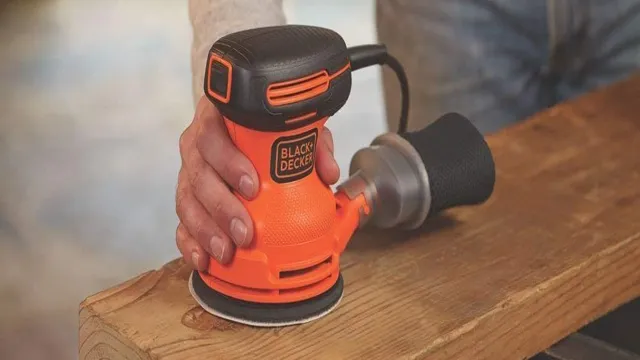
If you’re a woodworking enthusiast, it’s likely that you’ve come across the decision between using a belt sander and an orbital sander. They may look similar, but they have unique functions that cater to different sanding requirements. With each tool having its pros and cons, making the right choice can be perplexing.
But worry not! We’re here to clear the confusion and help you choose the best one for your project. Whether you’re a professional woodworker or a DIYer, keep reading to learn about the differences between belt sanders and orbital sanders.
What Are Belt Sanders?
Deciding whether to use a belt sander or an orbital sander depends on the specific task at hand. Belt sanders are a powerful and versatile tool that use a continuous abrasive belt to smooth surfaces. They are great for quickly removing large amounts of material, such as sanding down rough or uneven wood.
On the other hand, orbital sanders use a circular pad that moves in tiny circles to produce a smooth finish on surfaces. They are best for fine sanding, especially on flat surfaces such as tabletops or cabinets. Ultimately, the choice between which is better comes down to the type of job you need to complete.
For rough sanding, a belt sander is generally the better option while for finishing work, an orbital sander may be the better choice.
Power and Efficiency
Belt sanders are heavy-duty sanders that use a continuous loop of sandpaper, or belt, to sand a variety of surfaces, including wood, metal, and plastic. They are much more powerful and efficient than hand-held sanders and can take on larger tasks with ease. Belt sanders come in a variety of sizes, ranging from small handheld models to large industrial machines.
They are especially useful for removing rough materials quickly and efficiently, making them a popular tool for carpenters, construction workers, and metalworkers. Belt sanders typically have a powerful motor that drives the belt at high speeds, allowing them to sand large surfaces quickly and effectively. They also have a dust collection system that helps keep the work area clean.
Overall, belt sanders are a versatile and essential tool for anyone who works with wood, metal, or plastic.
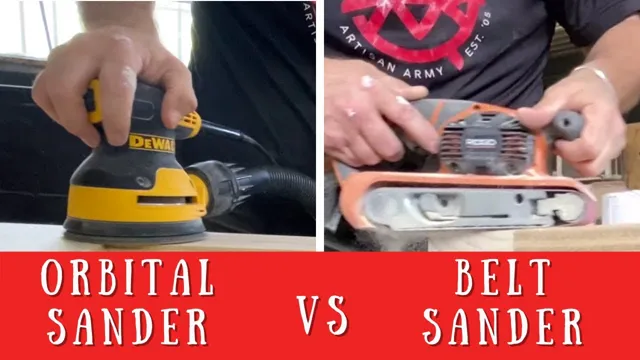
Versatility
Belt sanders are power tools used to smooth and shape various surfaces. They consist of a motor that rotates a continuous loop of sandpaper around two drums, allowing users to apply pressure and grind down materials with precision and speed. Belt sanders are incredibly versatile and can be used to tackle a wide range of DIY projects.
For example, they can be used to refinish floors, sand down rough wood edges, remove old paint or coatings, and even shape metal pieces. Belt sanders come in different sizes and strengths, making it easy to pick the right tool for the job. Overall, belt sanders are an essential tool for any DIY enthusiast or professional craftsman looking to make quick work of any sanding task.
Ease of Use
Belt sanders are a type of power tool that use a sanding belt to quickly and efficiently smooth and shape wood, metal, and other surfaces. They are typically handheld and come in a variety of sizes, with larger models generally providing more power and options for different grits and belt speeds. Belt sanders are known for being particularly effective at removing rough surfaces or deep scratches, making them a popular choice for woodworking, furniture making, and metalworking.
Additionally, many hobbyists and DIY enthusiasts find them to be a versatile and easy-to-use tool that can quickly provide professional-looking results. Overall, belt sanders offer a powerful and efficient solution for many different types of sanding and shaping projects.
What Are Orbital Sanders?
Deciding which is better between a belt sander and an orbital sander can be a tough decision. Belt sanders are powerful tools that excel at removing wood and metal quickly, while orbital sanders are ideal for finishing work and fine sanding. Orbitals sanders are called that because their sanding pad moves in a circular motion, rather than in a straight line like a belt sander.
This makes orbital sanders gentler on the material being sanded, resulting in a smoother finish. However, belt sanders are the better option if you need to remove a lot of material quickly. Ultimately, whether you choose a belt sander or an orbital sander will depend on your specific needs and project requirements.
Sanding Precision
Orbital sanders are handheld power tools that use a circular sanding pad that moves in an elliptical motion. They are great for sanding large, flat areas and can be used for both rough and fine sanding. The main benefit of using an orbital sander is the precision it offers.
It ensures that the sanding is consistent and evenly done, resulting in a smooth finish. This precision makes it an ideal tool for preparing surfaces for painting, staining or refinishing. Orbital sanders are also known for their easy maneuverability and their ability to work efficiently, making them a great tool for DIY projects or professional use.
If you’re looking for a tool to help you achieve a smooth and even finish on your woodworking or home improvement project, then an orbital sander is a great investment.
Dust Collection
Dust Collection Orbital sanders are versatile handheld sanding tools that are commonly used by woodworkers, carpenters, and DIY enthusiasts. They are designed to create smooth surfaces on various materials such as wood, metal, and plastic. These sanders are called orbital because of their circular or elliptical sanding motion, which reduces the likelihood of leaving swirl marks on the workpiece.
They are ideal for sanding large, flat surfaces such as tabletops, doors, and cabinets. Orbital sanders are generally less aggressive and easier to control compared to other types of sanders, making them a preferred option for beginners. It is important to note that using an orbital sander without proper dust collection can pose a health hazard by releasing fine dust particles into the air.
Therefore, it is recommended to use dust collection accessories such as vacuum attachments and dust extraction systems to minimize the risk of respiratory problems.
Variety of Applications
Orbital sanders are versatile tools used in a wide range of applications in woodworking, carpentry, and construction. These sanders are equipped with a circular sandpaper that moves in an orbital motion, providing a smooth and even finish to the surface being sanded. They can be used to sand wooden floors, furniture, and cabinets.
For instance, they are ideal for sanding rough-sawn lumber, removing old paint or varnish, or leveling out uneven surfaces. The most significant advantage of orbital sanders is that they don’t leave swirl marks, which can mar the surface’s appearance. This is because the circular pad not only moves in an orbital motion but also spins on its axis, ensuring a consistent sanding pattern.
Moreover, with various sanding grits that can be used with these sanders, from coarse to fine, they can be used to achieve the desired finish on any surface. If you are into woodworking, carpentry, or construction, investing in an orbital sander can make your work much more manageable, quicker, and efficient.
Which One is Better: Belt Sander or Orbital Sander?
When it comes to sanding, there are two popular options to choose from: the belt sander and the orbital sander. Both tools have their own strengths and weaknesses, so it’s important to know which is better for your specific needs. A belt sander is great for removing a lot of material quickly and is ideal for sanding large, flat surfaces.
The downside is that it can be difficult to control and can leave sander marks if not used properly. An orbital sander, on the other hand, is better suited for smaller, detailed work. It can be used on a variety of surfaces and is less likely to leave marks.
However, it can take longer to sand a surface than a belt sander. Ultimately, which sander is better for you will depend on your project and personal preferences. If you need to remove a lot of material quickly, go for the belt sander.
If you need to do detailed work, an orbital sander is the way to go.
Consider the Job Requirements
When it comes to sanding, the type of tool you need depends on the job requirements. Belt sanders are powerful and great for removing large amounts of material quickly. They are typically used for heavy-duty projects like sanding down hardwood floors or leveling out rough surfaces.
On the other hand, orbital sanders are better suited for lighter jobs like refinishing furniture or sanding drywall. They are designed to provide a smooth and even finish, making them ideal for tasks that require a delicate touch. So, which one is better? It all comes down to the job at hand.
If you need to remove a lot of material quickly, a belt sander is the way to go. However, if you need a tool for finer, more intricate work, an orbital sander is the better choice. Ultimately, it’s important to consider the project requirements before deciding which type of sander is right for you.
Take a Look at Your Workspace
If you’re someone who enjoys DIY projects, then you know that having the right tools is crucial for success. When it comes to sanding, you might be unsure which type of sander to use – belt sander or orbital sander? It really depends on the size of the job and the surface you’re working on. Belt sanders are great for removing a lot of material quickly, but they can also be a bit unwieldy and are best suited for larger areas.
Orbital sanders, on the other hand, are much more versatile and can be used on a variety of surfaces, including wood, metal, and plastic. They’re excellent for finish work and creating a smooth surface, but they can take longer to get the job done compared to belt sanders. Overall, it’s important to assess the size and scope of your project and consult with professionals or experts in the field to determine which type of sander will work best for your needs.
Conclusion: It Depends on Your Needs
In the end, it all depends on the job at hand. If you need heavy-duty material removal and aren’t too concerned with finesse, the belt sander is your best bet. But if you’re working on a more delicate project where precision is key, the orbital sander is the way to go.
So choose wisely, my DIY friends, and may your sanding endeavors be ever smooth.”
FAQs
What is the main difference between a belt sander and an orbital sander?
The main difference between a belt sander and an orbital sander is the type of motion they use. Belt sanders have a continuous loop of sandpaper that moves in one direction, while orbital sanders have a round sanding pad that moves in small circles.
Which type of sander is better for sanding large, flat surfaces?
Belt sanders are better for sanding large, flat surfaces because they cover more area and remove material more quickly.
Can you use an orbital sander for aggressive sanding jobs?
No, orbital sanders are not designed for aggressive sanding jobs. Belt sanders are better suited for these types of jobs.
Are belt sanders or orbital sanders easier to control?
Orbital sanders are typically easier to control because they have a smaller sanding surface and move in smaller circles. Belt sanders can be more difficult to control, especially for beginners.
Which type of sander is better for sanding curves or rounded edges?
Orbital sanders are better for sanding curves or rounded edges because they move in small circles and can conform to the shape of the workpiece.
Can you use the same sandpaper on a belt sander and an orbital sander?
No, belt sanders and orbital sanders use different types of sandpaper. Belt sanders use long, narrow strips of sandpaper that wrap around the machine, while orbital sanders use round sandpaper discs.
Which type of sander is better for refinishing furniture?
It depends on the job. If you need to remove a lot of material, a belt sander may be better. If you need to smooth out rough spots or prepare the surface for painting or staining, an orbital sander may be better.

